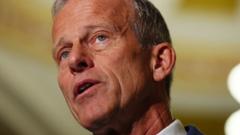India's recent economic trends suggest a decline, with GDP dropping to 5.4% between July and September, marking a significant slowdown compared to previous quarters. Despite its status as the fastest-growing major economy, several challenges loom, including weak consumer demand and high inflation, sparking debate among analysts and policymakers about the road ahead.
India's Economic Growth Faces Headwinds Amid Sluggish Data

India's Economic Growth Faces Headwinds Amid Sluggish Data
As GDP figures fall to a seven-quarter low of 5.4%, experts scrutinize the future of India's economy.
India's economy has hit a rough patch, with GDP growth recording a disappointing 5.4% for the July-September quarter, the lowest in over a year and significantly lagging behind the Reserve Bank of India's (RBI) forecast of 7%. This development raises questions about the sustainability of India's growth momentum, particularly when considering the factors contributing to the downturn.
Economists have pointed to a confluence of factors hindering the economy. Consumer demand appears to be dwindling, and private investments remain sluggish. Additionally, the government's retrenchment in spending—which has been a crucial support in recent years—adds to the downward pressure. Exports, particularly in the goods sector, have continued to underperform, with India's share in global goods exports remaining at just 2% in 2023. The performance of fast-moving consumer goods (FMCG) companies has also been lackluster, reflecting the broader economic sentiment.
Despite facing challenges, Finance Minister Nirmala Sitharaman has expressed optimism, suggesting that the current slowdown is not indicative of systemic problems, but rather a temporary outcome of reduced government spending during an election-focused period. She anticipates a rebound in the third quarter, emphasizing that India will remain the fastest-growing major economy amidst various hurdles, including issues in agriculture due to climate change.
Inflation is another concern, recently surging to 6.2% in October, largely influenced by skyrocketing vegetable prices. This persistent inflation has prompted the RBI to maintain high-interest rates for nearly two years, creating a complex dilemma. While curbing inflation is essential, these restrictive rates can hinder growth by making loans more expensive for consumers and businesses, ultimately affecting overall economic activity.
Compounding this issue is a dichotomy in economic performance across sectors. The old economy, characterized by agriculture and small businesses, continues to struggle, awaiting necessary reforms, while the new economy, significantly propelled by the growth in services exports post-pandemic, has peaked. Reports suggest that urban consumption is beginning to decline, further complicating the economic landscape.
Despite the ongoing complexities, some experts point to potential bright spots in rural demand, which has benefited from good monsoon efforts and rising food prices. However, the excessive tariffs imposed in recent years—rising from 5% in 2013-14 to 17%—create additional barriers for businesses trying to compete globally, as the cost of goods increases.
There is a growing concern that the government's current strategy of maintaining a robust rupee through foreign currency interventions might inadvertently stifle the competitiveness of Indian goods abroad. Critics assert that this short-term focus on currency value could detract from the more pressing need for critical reforms to stimulate investment, exports, and job creation.
Looking forward, experts are debating the best approach to foster economic growth and consumer demand in the wake of ongoing challenges. Discussions around government employment schemes aimed at raising wages and enhancing purchasing power, alongside calls for lower tariffs to attract exports, are gaining traction.
While the government maintains a hopeful outlook, emphasizing industry stability and declining extreme poverty rates, many remain skeptical about India's long-term ambitions without the necessary reforms to sustain and bolster economic growth. The need for a reevaluation of strategies and measures to ensure broad-based and sustained economic progress is becoming increasingly evident.
Economists have pointed to a confluence of factors hindering the economy. Consumer demand appears to be dwindling, and private investments remain sluggish. Additionally, the government's retrenchment in spending—which has been a crucial support in recent years—adds to the downward pressure. Exports, particularly in the goods sector, have continued to underperform, with India's share in global goods exports remaining at just 2% in 2023. The performance of fast-moving consumer goods (FMCG) companies has also been lackluster, reflecting the broader economic sentiment.
Despite facing challenges, Finance Minister Nirmala Sitharaman has expressed optimism, suggesting that the current slowdown is not indicative of systemic problems, but rather a temporary outcome of reduced government spending during an election-focused period. She anticipates a rebound in the third quarter, emphasizing that India will remain the fastest-growing major economy amidst various hurdles, including issues in agriculture due to climate change.
Inflation is another concern, recently surging to 6.2% in October, largely influenced by skyrocketing vegetable prices. This persistent inflation has prompted the RBI to maintain high-interest rates for nearly two years, creating a complex dilemma. While curbing inflation is essential, these restrictive rates can hinder growth by making loans more expensive for consumers and businesses, ultimately affecting overall economic activity.
Compounding this issue is a dichotomy in economic performance across sectors. The old economy, characterized by agriculture and small businesses, continues to struggle, awaiting necessary reforms, while the new economy, significantly propelled by the growth in services exports post-pandemic, has peaked. Reports suggest that urban consumption is beginning to decline, further complicating the economic landscape.
Despite the ongoing complexities, some experts point to potential bright spots in rural demand, which has benefited from good monsoon efforts and rising food prices. However, the excessive tariffs imposed in recent years—rising from 5% in 2013-14 to 17%—create additional barriers for businesses trying to compete globally, as the cost of goods increases.
There is a growing concern that the government's current strategy of maintaining a robust rupee through foreign currency interventions might inadvertently stifle the competitiveness of Indian goods abroad. Critics assert that this short-term focus on currency value could detract from the more pressing need for critical reforms to stimulate investment, exports, and job creation.
Looking forward, experts are debating the best approach to foster economic growth and consumer demand in the wake of ongoing challenges. Discussions around government employment schemes aimed at raising wages and enhancing purchasing power, alongside calls for lower tariffs to attract exports, are gaining traction.
While the government maintains a hopeful outlook, emphasizing industry stability and declining extreme poverty rates, many remain skeptical about India's long-term ambitions without the necessary reforms to sustain and bolster economic growth. The need for a reevaluation of strategies and measures to ensure broad-based and sustained economic progress is becoming increasingly evident.





















